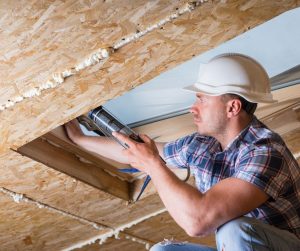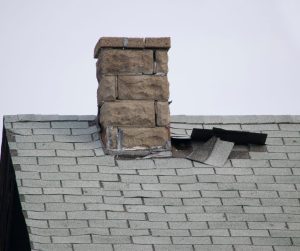Roof leaks can be frustrating for homeowners. A constant water drip would drive anyone insane. Knowing you have a leak can be obvious when you see water spots or water dripping from your ceiling. While it can be easy to recognize leaks, it can also be difficult to find the source of that leak.
How to Spot a Roof Leak
 The easiest way to spot a roof leak is to see a visible leak. Water leaks from your roof can cause water spots on your ceiling and or your walls. It can also create water spots or wet roof decking which is visible through the attic if you have one. Water leaks can also cause water drips from your ceiling, which you may hear. If you notice these water spots or hear the drip from your ceiling, you have a leak. The hard part is finding the true source of that leak. If you have water dripping from your ceiling, the source of the leak may be right above the water. Though it may also be several feet away and deceiving. Water and or condensation on your ceiling, walls, or in your attic aren’t always proof of a leak though. This is where it gets tricky. Roofs without proper ventilation can develop moisture issues. These moisture issues can be severe, they can cause mold, mildew, staining, and water damage. It’s easy to confuse this with a roof leak since roof leaks also produce similar damage. Another thing to watch for is a plumbing leak, since it can also cause similar damage. Keep these things in mind and weigh out all options before panicking. It may not be as bad as you think.
The easiest way to spot a roof leak is to see a visible leak. Water leaks from your roof can cause water spots on your ceiling and or your walls. It can also create water spots or wet roof decking which is visible through the attic if you have one. Water leaks can also cause water drips from your ceiling, which you may hear. If you notice these water spots or hear the drip from your ceiling, you have a leak. The hard part is finding the true source of that leak. If you have water dripping from your ceiling, the source of the leak may be right above the water. Though it may also be several feet away and deceiving. Water and or condensation on your ceiling, walls, or in your attic aren’t always proof of a leak though. This is where it gets tricky. Roofs without proper ventilation can develop moisture issues. These moisture issues can be severe, they can cause mold, mildew, staining, and water damage. It’s easy to confuse this with a roof leak since roof leaks also produce similar damage. Another thing to watch for is a plumbing leak, since it can also cause similar damage. Keep these things in mind and weigh out all options before panicking. It may not be as bad as you think.
Where Is the Roofing Leak Coming From?
Your roof can form a leak anywhere, but there are a few places where leaking is more common. If you suspect a leak, check these areas first.
Leaks Around Your Chimney
 The chimney is one of the most common places for a roof leak. Most of the time, it’s due to cracked or damaged flashing. Roof flashing is a thin strip of metal installed around the roof. It provides a seal where the roof intersects to help waterproof the perimeter. Chimney flashing bends at a 90° angle. One side is under the shingles and the other sides nailed into the chimney. The top of the flashing is then sealed with caulk. Caulk can and will fail over time. Another cause can be an uncovered chimney. Not having a cover allows rain to go into the chimney. Condensation in the chimney can also cause leaks.
The chimney is one of the most common places for a roof leak. Most of the time, it’s due to cracked or damaged flashing. Roof flashing is a thin strip of metal installed around the roof. It provides a seal where the roof intersects to help waterproof the perimeter. Chimney flashing bends at a 90° angle. One side is under the shingles and the other sides nailed into the chimney. The top of the flashing is then sealed with caulk. Caulk can and will fail over time. Another cause can be an uncovered chimney. Not having a cover allows rain to go into the chimney. Condensation in the chimney can also cause leaks.
Leaks from Missing or Broken Shingles
Missing shingles can be a very obvious sign on a roof leak. Missing shingles are easy to see since they’re the outermost layer of your roof. They provide protection against bad weather, so missing shingles could let in water. Strong wind or storms can cause shingles to rip off, creating missing shingles. Hail or debris could penetrate your roof during these storms, leading to more damage. In some cases, this damage is harder to recognize without the help of a professional. Broken shingles are not as easy to recognize as missing shingles. Having broken shingles is common especially if your house is older or has its original roof.
Leaks from Cracked Roof Vents
Roof vents look like small pipes that protrude from your roof. They’re responsible for getting rid of excess moisture from the inside of your house. Roof vents usually have flashing around them alongside a rubber boot to help seal the top. Like mentioned in the chimney section, flashing can become worn out. This can cause a leak. The rubber boot can also fail, in as little as seven years. It’s important to check these often to maintain them and prevent leaks before they occur.
Unsealed Roof Valley Leaks
A roof valley is an area where two planes of the roof come together. If the valleys aren’t sealed right, a leak can occur. A professional roofer can detect this. They can look around the seams of your roof for wet areas, which detect a poor seal. This is a very complex type of leak, which means only professionals should seal roof valleys.
Fixing a Leaky Roof
Now that you’ve spotted and are aware of a leak from your roof, here are the next few steps you can take. The first of these is to limit the flow of water, which means putting a bucket underneath the leak if possible. This will catch excess water and prevent more damage. The next step is to move anything that the water could damage. You should also move anything underneath ceilings that may collapse from damage. Water can ruin furniture, electronics, books, or other possessions. Moving them as soon as possible will prevent damage and possible mold. The next step is to call a roofer of course. Let them know where you see the leak or suspect the source is. Sometimes it may look obvious but be more complex, and sometimes it’s simple for a roofer to notice. They know what to look for and can actually inspect from the roof, which is helpful. One thing you want to be sure NOT to do when you identify a roof leak is to puncture the ceiling where the drip is. People do this to allow water buildup to drain, but this can be dangerous. You can’t be sure of the amount of water or how much damage is up there. The ceiling could collapse if you choose to do this by yourself without a professional.
Conclusion
Locating a leak in your roof can be frustrating, especially if you try to handle it on your own. Luckily professional roofing companies know how to find and repair leaks with ease. After learning common leak spots, you may be able to locate the source on your own. This does NOT mean you should try to fix it on your own. Attempting this can result in severe damage if it goes wrong. If you spot the leak or what you think is the source, let us know and we can help you fix it. If you don’t know where the leak is coming from, that’s okay too. We can still help! Roof leaks don’t get better on their own. The sooner you can get a professional involved, the less damage you’ll have to pay for and repair. Contact us today for a quote!

